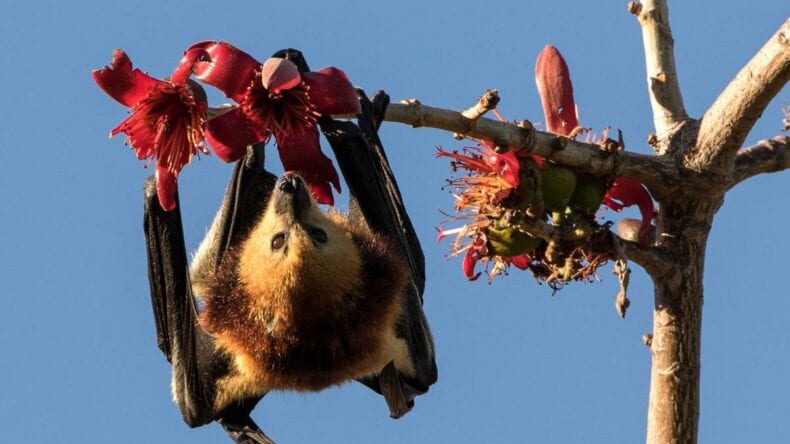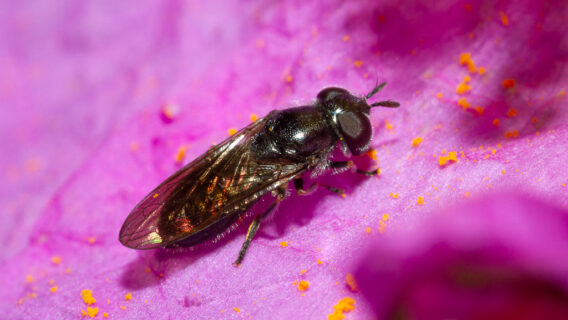Australia’s Reptiles Threatened by Invasive Species, Climate Change according to the IUCN Red List

The Mauritian Flying Fox, an important pollinator, is now listed as Endangered due to a culling campaign, today’s update also reveals. There is some good news after the rediscovery of four South American amphibian species previously thought to be extinct.
The IUCN Red List now includes 93,577 species, of which 26,197 are threatened with extinction.
“Today’s IUCN Red List update reveals the onslaught of threats that our planet’s biodiversity is facing,” says IUCN Director General Inger Andersen. “Invasive species, changes to fire patterns, cyclones and human-wildlife conflict are just some of the many threats wreaking havoc on our planet’s ecosystems. As species from Mauritius to Australia slip towards extinction we risk losing a part of our culture and our identity, as well as the life-supporting benefits these species provide by pollinating our crops or preserving healthy soils.”
IUCN Director General Inger Andersen
The UN Strategic Plan for Biodiversity (2011-2020) calls for countries to bring about the sustained recovery of species most at risk of extinction. Today’s update of The IUCN Red List of Threatened Species shows that urgent action is needed to conserve threatened species. At the national level, Jane Smart, Global Director of IUCN’s Biodiversity Conservation Group, speaking at a meeting of the Convention on Biological Diversity this week called for countries to urgently fast track conservation action for threatened species.
Australia’s reptiles threatened by invasive species and climate change
Australia’s reptiles face rising threats from invasive species and climate change, with 7% now threatened with extinction, The IUCN Red List update reveals after a comprehensive survey of the continent’s reptiles. The Red List now includes 975 Australian reptile species – almost all of Australia’s reptiles, the majority of them endemic to the continent.
Invasive species are the main threat to the survival of over half of these threatened reptiles. A recent study found that invasive feral cats alone are estimated to kill about 600 million reptiles each year. One of the many species of reptile predated by feral cats is the Grassland Earless Dragon (Tympanocryptis pinguicolla), which moved from the Vulnerable to the Endangered category. Changes to the intensity and frequency of fires – caused by a combination of agricultural management, the loss of traditional indigenous burning practices and invasive weeds – are an additional threat to this species. Like many Australian species, the Grassland Earless Dragon is naturally adapted to the semi-natural wildfire patterns that were in place prior to European settlement.
Another invasive species threatening Australia’s reptiles is the toxic Cane Toad, which was introduced to Australia in 1935. For the Mitchell’s Water Monitor (Varanus mitchelli), which enters the Red List as Critically Endangered, dining on the toxic Cane Toad has resulted in population declines of up to 97% in some areas, following the arrival of toads. Australia’s reptiles are particularly vulnerable to poisoning by the Cane Toad as Australia has no native toads or other species that produce the same toxins.
Climate change is also increasingly threatening Australia’s reptiles, including the Vulnerable Bartle Frere Cool-skink (Techmarscincus jigurru), a cold-adapted species found only on the summit of Queensland’s tallest mountain, Mount Bartle Frere. A 1°C increase in temperature is likely to result in a loss of 50% of the Cool-skink’s population within 30 years, as there are no cooler areas for the animal to move to.
“This Red List update highlights the vulnerability of Australia’s lizards and snakes to invasive alien species, including the toxic Cane Toad and feral cats, often in combination with threats from habitat loss due to invasive weeds, development, and fire,” says Philip Bowles, IUCN SSC Snake and Lizard Red List Authority Coordinator. “Understanding the threats to each of Australia’s native reptile species will help us effectively work with the Australian Government, local conservation groups and Aboriginal people to address them.”
Philip Bowles, IUCN SSC Snake and Lizard Red List Authority Coordinator
Australia’s unusually diverse reptiles evolved in isolation from those elsewhere and represent almost 10% of the world’s reptile fauna. Some of these animals are important components of the environment and wider food chain. For indigenous people, Australian reptiles, particularly the carnivorous and frugivorous lizards and pythons, are an important part of their culture and are used as emblems and in storytelling, as well as food.
Invasive plants threaten Azores island beetles
Over a hundred insect species from the Portuguese islands of the Azores have been assessed for the IUCN Red List, and 74% of these are threatened with extinction. Habitat degradation exacerbated by invasive plant species, land use change and a drying climate are the main threats. All 12 assessed species of Ironclad Beetles (Tarphius spp.) are considered threatened with extinction. These beetles rely on decomposing wood, mosses and fern cover for survival, but the Kahili Ginger (Hedychium gardnerianum), a plant introduced from the Himalayas, is slowly replacing native plant species. The Terceira Island Ironclad Beetle (Tarphius relictus) has been particularly affected by this change and is now limited to a range of less than one hectare. The recent establishment of a protected area by the Azorean Government, based on the draft assessment of the Ironclad Beetle, provides some hope for the future of this species.
“Beetles are key components of ecosystems, fulfilling critical functions such as predation and pollination,” says Axel Hochkirch, Chair of the IUCN SSC Invertebrate Conservation Sub-Committee. “Small changes in habitats have great impacts on invertebrates and species endemic to islands are particularly threatened.”
Axel Hochkirch, Chair of the IUCN SSC Invertebrate Conservation Sub-Committee
Mauritian Flying Fox now Endangered following culling campaign
The Mauritian Flying Fox (Pteropus niger), a large bat species found only on the Indian Ocean islands of Mauritius and Réunion, has moved from Vulnerable to Endangered on The IUCN Red List. The bat population fell by an estimated 50% between 2015 and 2016 largely due to government-implemented culling of the bats, motivated by alleged damage to lychee and mango fruit crops.
The species also faces threats from deforestation, cyclones, illegal hunting and accidental mortality from power lines. Cyclones have caused population declines of over 95% in flying fox species on other islands, and remain an important threat to the Mauritian Flying Fox as cyclones are predicted to increase in frequency and intensity in the region.
The species fulfils a crucial role in Mauritius ecosystems by pollinating native plants and dispersing seeds. The IUCN SSC Human-Wildlife Conflict Task Force is working with the Mauritian Government, fruit growers, scientists and other stakeholders — including the Mauritian Wildlife Foundation, recipient of an IUCN Save Our Species Rapid Action Grant — to address the underlying issues and to seek out alternative ways of protecting fruit crops, such as the use of netting and modernisation of orchard management. In 2015, IUCN warned in a statement that culling will very likely result in the species moving closer to extinction on The IUCN Red List. Meanwhile, through conflict resolution dialogue, the Task Force together with the IUCN SSC Bat Specialist Group and the Mauritian Government have made promising progress towards developing acceptable solutions for all affected parties, and no further culls have taken place since 2016.
Amphibian species rediscovered
Despite extremely high levels of threat to amphibians globally, there is some good news for amphibians after four species previously considered as Critically Endangered (Possibly Extinct) or Extinct were rediscovered in Colombia and Ecuador. The Rio Pescado Stubfoot Toad (Atelopus balios), Quito Stubfoot Toad (Atelopus ignescens) and Atelopus nanay were all suspected to have disappeared due to the effects of the deadly chytridiomycosis disease. The Carchi Andes Toad (Rhaebo colomai) was so heavily impacted by habitat loss that it was also feared to be gone forever.
“While these rediscoveries are encouraging news, the species are still negatively impacted by human-induced threats,” says Jennifer Luedtke, IUCN SSC Amphibian Red List Authority Coordinator. “These species still have to contend with severe habitat destruction and degradation, predation by non-native trout species, chytridiomycosis, and the effects of a changing climate, highlighting the urgent need to improve the conservation of these species to prevent their extinction.”
Jennifer Luedtke, IUCN SSC Amphibian Red List Authority Coordinator
Japanese earthworms assessed for the first time
Of the 43 native species of Japanese earthworms assessed for the Red List through funding from the IUCN – Toyota Motor Corporation Partnership, three species are considered threatened with extinction (Eisenia anzac, Drawida moriokaensis and Drawida ofunatoensis). Agricultural intensification, urban expansion and radioactive fallout from World War II and the 2011 Fukushima Daiichi reactor explosion are the main threats to these species.
Earthworms help maintain healthy soils, increase soil aeration and infiltration of rain. They are also the foundation of many food chains. In Japan, earthworms are traditionally used as fishing bait and medicine. They are also culturally significant, with mythical stories told of giant, singing earthworms ascending to heaven and becoming dragons.
Demand for perfume threatens one of the world’s most valued woods
The Aquilaria malaccensis tree, which produces one of the world’s most valued woods, moved from Vulnerable to Critically Endangered as logging and deforestation caused populations to decline by more than 80% over the past 150 years. Agarwood develops in the core of some Aquilaria trees after they are infected by a mould and the tree produces a fragrant, dark resin as a defence mechanism against the infection. It is difficult to tell which wild trees contain agarwood, leading poachers to cut down large numbers of trees in search of the precious wood. Aquilaria malaccensis is one of the world’s preferred agarwood-producing species used for perfumery.




